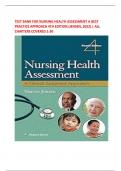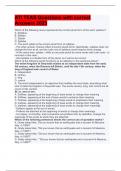TEST BANK FOR NURSING HEALTH ASSESSMENT A BEST
PRACTICE APPROACH 4TH EDITION (JENSEN, 2022) | ALL
CHAPTERS COVERED 1-30
,Table of Contents
Chapter 1.The NURSE’s Role In Health Assessment ..................................................................................... 3
Chapter 2. Health History And Interview .................................................................................................... 13
Chapter 3. Assessment Techniques, Safety, And Infection Control............................................................ 30
Chapter 4. Documentation And Interdisciplinary Communication ............................................................ 47
Chapter 5. Vital Signs And General Survey ................................................................................................. 57
Chapter 6. Pain Assessment ........................................................................................................................ 79
Chapter 7. Nutrition Assessment ................................................................................................................ 85
Chapter 8. Assessment Of Developmental Stages ...................................................................................... 98
Chapter 9. Mental Health, Violence, And Substance Use Disorder .......................................................... 100
Chapter 10. Cultural Assessment .............................................................................................................. 116
Chapter 11. Skin, Hair, And Nails .............................................................................................................. 131
Chapter 12.Head And Neck, With Vision And Hearing Basics................................................................... 146
Chapter 13. Eye Assessment For Advanced And Specialty Practice ......................................................... 162
Chapter 14.Ear Assessment For Advanced And Specialty Practice........................................................... 177
Chapter 15. Nose, Sinuses, Mouth, And Throat........................................................................................ 192
Chapter 16. Thorax And Lungs .................................................................................................................. 208
Chapter 17. Heart And Neck Vessels ........................................................................................................ 220
Chapter 18. Peripheral Vascular With Lymphatics ................................................................................... 233
Chapter 19. Breasts And Axillae ................................................................................................................ 246
Chapter 20. Abdominal Assessment ......................................................................................................... 259
Chapter 21. Musculoskeletal Assessment ................................................................................................ 273
Chapter 22. Neurological And Mental Status ........................................................................................... 288
Chapter 23. Male Genitalia And Rectum .................................................................................................. 306
Chapter 24. Female Genitalia And Rectum ............................................................................................... 323
Chapter 25. Pregnancy .............................................................................................................................. 343
Chapter 26. Newborns And Infants .......................................................................................................... 355
Chapter 27. Children And Adolescents ..................................................................................................... 363
Chapter 28. Older Adults .......................................................................................................................... 373
Chapter 29. Assessment Of The Hospitalized Adult ................................................................................. 379
Chapter 30. Head-To Toe Assessment Of Adult........................................................................................ 384
,Nursing Health Assessment A Best Practice Approach 4th Edition Jensen Test Bank
Chapter 1.The NURSE’s Role In Health Assessment
1. After Completing An Initial Assessment Of A Patient, The NURSE Has Charted That His
Respirations Are Eupneic And His Pulse Is 58 Beats Per Minute. These Types Of Data Would Be:
A. Objective.
B. Reflective.
C. Subjective.
D. Introspective.
ANSWER: A
Objective Data Are What The Health Professional Observes By Inspecting, Percussing, Palpating,
And Auscultating During The Physical Examination. Subjective Data Is What The Person Says About Him
Or Herself During History Taking. The Terms Reflective And Introspective Are Not Used To Describe Data.
DIF: Cognitive Level: Understanding (Comprehension) REF: Dm. 2
MSC: Client Needs: Safe And Effective Care Environment: Management Of Care
2. A Patient Tells The NURSE That He Is Very Nervous, Is Nauseated, And Feels Hot. These Types Of
Data Would Be:
A. Objective.
B. Reflective.
C. Subjective.
D. Introspective.
ANSWER: C
Subjective Data Are What The Person Says About Him Or Herself During History Taking. Objective
Data Are What The Health Professional Observes By Inspecting, Percussing, Palpating, And Auscultating
During The Physical Examination. The Terms Reflective And Introspective Are Not Used To Describe
Data.
DIF: Cognitive Level: Understanding (Comprehension) REF: Dm. 2
MSC: Client Needs: Safe And Effective Care Environment: Management Of Care
3. The Patients Record, Laboratory Studies, Objective Data, And Subjective Data Combine To Form
The:
A. Data Base.
, B. Admitting Data.
C. Financial Statement.
D. Discharge Summary. ANSWER: A
Together With The Patients Record And Laboratory Studies, The Objective And Subjective Data Form The
Data Base. The Other Items Are Not Part Of The Patients Record, Laboratory Studies, Or Data.
DIF: Cognitive Level: Remembering (Knowledge) REF: Dm. 2
MSC: Client Needs: Safe And Effective Care Environment: Management Of Care
4. When Listening To A Patients Breath Sounds, The NURSE Is Unsure Of A Sound That Is Heard.
The NURSEs Next Action Should Be To:
A. Immediately Notify The Patients Physician.
B. Document The Sound Exactly As It Was Heard.
C. Validate The Data By Asking A Coworker To Listen To The Breath Sounds.
D. Assess Again In 20 Minutes To Note Whether The Sound Is Still Present. ANSWER: C
When Unsure Of A Sound Heard While Listening To A Patients Breath Sounds, The NURSE Validates The
Data To Ensure Accuracy. If The NURSE Has Less Experience In An Area, Then He Or She Asks An Expert
To Listen.
DIF: Cognitive Level: Analyzing (Analysis) REF: Dm. 2
MSC: Client Needs: Safe And Effective Care Environment: Management Of Care
5. The NURSE Is Conducting A Class For New Graduate NURSEs. During The Teaching Session, The
NURSE Should Keep In Mind That Novice NURSEs, Without A Background Of Skills And Experience From
Which To Draw, Are More Likely To Make Their Decisions Using:
A. Intuition.
B. A Set Of Rules.
C. Articles In Journals.
D. Advice From Supervisors. ANSWER: B
Novice NURSEs Operate From A Set Of Defined, Structured Rules. The Expert Practitioner Uses
Intuitive Links.
DIF: Cognitive Level: Understanding (Comprehension) REF: Dm. 3 MSC: Client Needs: General
6. Expert NURSEs Learn To Attend To A Pattern Of Assessment Data And Act Without Consciously





